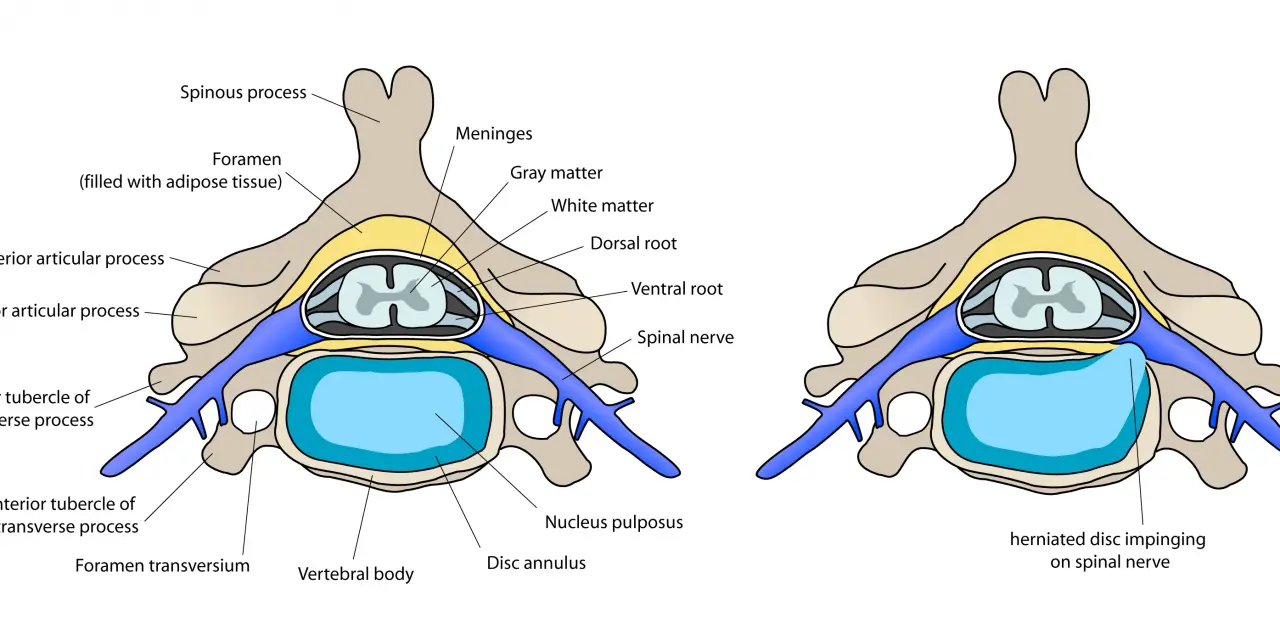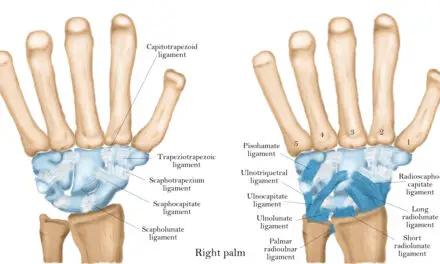Massage therapists and personal trainers often hear from their clients or patients that their back “blew out” or their physician had diagnosed them with a herniated disc. This often causes them to believe that their back or neck pain is attributed to a disc bulge.
Massage educator Whitney Lowe, who runs Orthopedic Massage Education & Research Institute in Sisters, Oregon, wrote on his blog that intervertebral discs can manage a high compressive load between the adjacent vertebrae. “The idea many people have when they hear about a ‘blown-out disc’ is that some acute force caused a previously normal disc to rapidly protrude to one side as a result of the sudden force,” Lowe wrote. “In the lumbar region the blown-out disc is frequently suggested to result from lifting heavy loads and having sudden back pain.”
In fact, the lumbar spine (L5-S1) can sustain an average of about 4.4 kilonewtons (standard deviation 1.9 kN), or almost 1,000 pounds of compressive force, according to a 1989 study that averaged 307 lumbar segments. A more recent study published in Spine showed that the cervical spine could withstand compressive forces of up to 2.4 kN, or about 540 pounds among 22 subjects. (1) While most people — including some clinicians — think that disc herniation is caused by a sudden force, most of such cases is more likely caused by repetitive movements or holding a certain position for a long time.
“If there is an acute disc herniation, it’s generally the last straw, occurring to a disc that was already protruding and seriously weakened,” Lowe wrote.
Even among those who are diagnosed with a disc herniation or a disc problem, it does not necessarily correlate to back or neck pain. A recent systematic review of 33 papers with a total of 3,110 subjects that was published in American Society of Neuroradiology (3) found a lack of pain associated with spine degeneration among a majority of the subjects. “Disk degeneration prevalence ranged from 37% of asymptomatic individuals 20 years of age to 96% of those 80 years of age,” the authors wrote. Thirty percent of those in their twenties had bulging disc, compared to 84 percent among subjects in their eighties.
Thus, these MRI findings of degenerative changes on the spine and disc is part of a normal aging process rather than a “disease” that needs to be “fixed.” The researchers wrote, “The finding that 50% of asymptomatic individuals 30 –39 years of age have disk degeneration, height loss, or bulging suggests that even in young adults, degenerative changes may be incidental and not causally related to presenting symptoms.
The results from this systematic review strongly suggest that when degenerative spine findings are incidentally seen (i.e., as part of imaging for an indication other than pain or an incidental disk herniation at a level other than where a patient’s pain localizes), these findings should be considered as normal age-related changes rather than pathologic processes.
Another study from Japan that was published in Spine (4) also found a similar pattern in the cervical spine among 1,211 adults between ages 20 and 70. These subjects show no symptoms of pain associated with cervical disc herniation. Even young, asymptomatic subjects in their twenties had a high rate of disc herniation (men 73%, women 78%). Thus, these studies provide some evidence that back and neck pain are not necessarily caused by disc herniation and other common spine disorders.
“Commonly used expressions like the blown-out disc (or slipped disc; also erroneous because the disc doesn’t slip), often lead to inaccurate models of pathophysiology,” Lowe wrote. “As a result, treatment decisions may be based on these incorrect models and lead to poor outcomes. When you hear these types of phrases, make sure you understand the real underlying pathology and make treatment decisions based on accurate physiology.”
References
- Przybyla AS, Skrzypiec D, Pollintine P, Dolan P, Adams MA. Strength of the cervical spine in compression and bending. Spine (Phila Pa 1976). 2007 Jul 1;32(15):1612-20.
-
Jäger M, Luttmann A. Biomechanical analysis and assessment of lumbar stress during load lifting using a dynamic 19-segment human model. Ergonomics. 1989 Jan;32(1):93-112.
- Brinjikji W, Luetmer PH, Comstock B, et al. Systematic literature review of imaging features of spinal degeneration in asymptomatic populations. AJNR Am J Neuroradiol. 2015;36(4):811–816. doi:10.3174/ajnr.A4173.
-
Nakashima H1, Yukawa Y, Suda K, Yamagata M, Ueta T, Kato F. Abnormal findings on magnetic resonance images of the cervical spines in 1211 asymptomatic subjects. Spine (Phila Pa 1976). 2015 Mar 15;40(6):392-8. doi: 10.1097/BRS.0000000000000775.
A native of San Diego for nearly 40 years, Nick Ng is an editor of Massage & Fitness Magazine, an online publication for manual therapists and the public who want to explore the science behind touch, pain, and exercise, and how to apply that in their hands-on practice or daily lives.
An alumni from San Diego State University with a B.A. in Graphic Communications, Nick also completed his massage therapy training at International Professional School of Bodywork in San Diego in 2014.
When he is not writing or reading, you would likely find him weightlifting at the gym, salsa dancing, or exploring new areas to walk and eat around Southern California.





